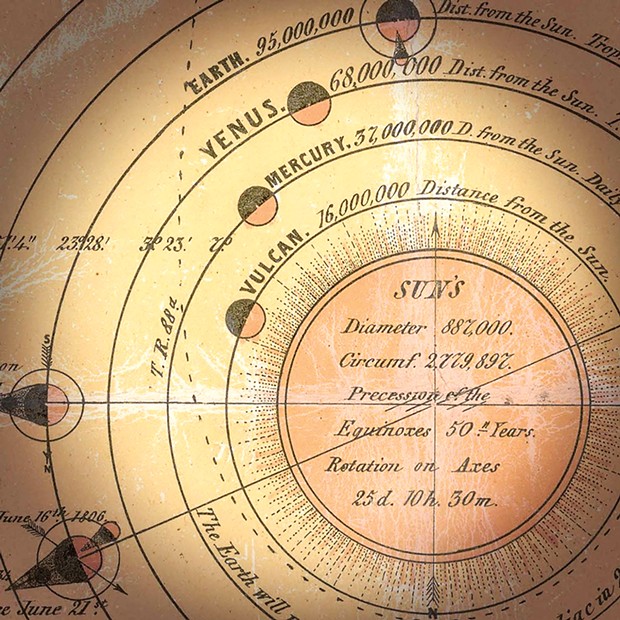
Image by E. Jones and G.W. Newman, Library of Congress, public domain
Detail from 1846 lithograph of the solar system showing the hypothetical planet Vulcan.
[
{
"name": "Top Stories Video Pair",
"insertPoint": "7",
"component": "17087298",
"parentWrapperClass": "fdn-ads-inline-content-block",
"requiredCountToDisplay": "1"
}
]
Vulcan was the Roman god of fire; he was also ugly. The good news is that he somehow got to marry the goddess Venus, who was something of a catch. The bad news is she was constantly unfaithful. Although sounding like a bit of a loser, Vulcan had the last laugh, giving us our word for one of the most potent of nature's forces: volcanoes. "Vulcan" crops up in other contexts, too. For instance, "vulcanization" is the process for hardening natural or synthetic rubber. And (as all pre-TNG trekkies know), the imperturbable Mr. Spock is the result of a rather improbable union, since he's half Vulcan and half human, and his home planet is Vulcan.
My favorite Vulcan story, however, has to do with the search for a missing planet. More than 300 years ago, grumpy-genius Isaac Newton came up with his law of gravity: The attractive force between any two objects depends on their masses and distance apart, thus explaining virtually all motion in our solar system. In test after test, it proved to be correct, until 19th century astronomers began to take a really good look at Mercury's orbit, the most elliptical orbit of all planets (Pluto having been downgraded from planetary status). The axis of Mercury's ellipse doesn't stay constant, but swings slowly around the sun in a motion known as "perihelion precession." Around 200 years ago, astronomers measured that precession and found it wanting. Although they could account for most of it by calculating the effects the other planets have on Mercury, there was still something wrong. It was a little more that Newton's law predicted. How come?
French astronomer Urbain Jean Joseph Le Verrier was the celestial whiz of his time, having correctly predicted the existence of Neptune from discrepancies in Uranus' orbit. He proposed in 1859 that the discrepancy in Mercury's precession could be explained by a hitherto unseen planet — "Vulcan" —orbiting between Mercury and the sun. The search began, and few years later Le Verrier naively put his trust in a single observation made by French physician and amateur astronomer Edmond Lescarbault, who claimed to have seen a planet transit (pass across) the face of the sun. While Lescarbault was awarded the Légion d'Honneur for his part, Le Verrier went on to calculate (to unbelievable precision) the orbital period of Vulcan: 19 days and 17 hours, at an inclination of 12 degrees 10 minutes.
Over the next half-century, dozens of such transits were observed, all claiming to be proof of the existence of Vulcan. Trouble was, they disagreed with each other and when the putative planet failed to show up during total solar eclipses — when it should have been readily observable — doubts crept in. It took a young German physicist reformulating Newton's "classical" law of gravity to unravel the conundrum. According to Albert Einstein's 1916 Theory of General Relativity, Newton's "spooky action at a distance" (where two masses are pulled toward each other by something like an invisible rubber band), what looks like attraction is actually a feature of the "warping" of an underlying ubiquitous matrix: spacetime. In Einstein's counter-intuitive way of looking at it, mass tells spacetime how to curve while the curvature of spacetime tells mass how to move.
When the curvature of spacetime caused by the sun's mass is added to the effects of the other planets, the discrepancy in Mercury's perihelion precession disappears. In fact, this was the first empirical test of Einstein's theory and it passed with flying colors. So the raison d'être for Vulcan's existence — not the Roman god of fire or Spock's home, but a planet once thought to orbit very close to the sun — went away. Too bad. Vulcan sounds so right for the name of a fiery, sun-blasted world.
Barry Evans (he/him, [email protected]) wishes his hero Isaac Newton had been, well, nicer.
more from the author
-
Doubting Shakespeare, Part 3: Whodunnit?
- May 9, 2024
-
Doubting Shakespeare, Part 2: Problems
- May 2, 2024
-
Doubting Shakespeare, Part 1: Stratfordians vs. anti-Stratfordians
- Apr 25, 2024
- More »
Latest in Field Notes
Readers also liked…
-
Trouble on the Line: The Reality Part 2
- Nov 3, 2022
































